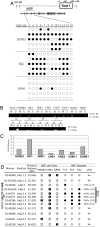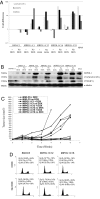Chromosome 14 transfer and functional studies identify a candidate tumor suppressor gene, mirror image polydactyly 1, in nasopharyngeal carcinoma
- PMID: 19667180
- PMCID: PMC2732794
- DOI: 10.1073/pnas.0900198106
Chromosome 14 transfer and functional studies identify a candidate tumor suppressor gene, mirror image polydactyly 1, in nasopharyngeal carcinoma
Abstract
Chromosome 14 allelic loss is common in nasopharyngeal carcinoma (NPC) and may reflect essential tumor suppressor gene loss in tumorigenesis. An intact chromosome 14 was transferred to an NPC cell line using a microcell-mediated chromosome transfer approach. Microcell hybrids (MCHs) containing intact exogenously transferred chromosome 14 were tumor suppressive in athymic mice, demonstrating that intact chromosome 14 NPC MCHs are able to suppress tumor growth in mice. Comparative analysis of these MCHs and their derived tumor segregants identified 4 commonly eliminated tumor-suppressive CRs. Here we provide functional evidence that a gene, Mirror-Image POLydactyly 1 (MIPOL1), which maps within a single 14q13.1-13.3 CR and that hitherto has been reported to be associated only with a developmental disorder, specifically suppresses in vivo tumor formation. MIPOL1 gene expression is down-regulated in all NPC cell lines and in approximately 63% of NPC tumors via promoter hypermethylation and allelic loss. SLC25A21 and FOXA1, 2 neighboring genes mapping to this region, did not show this frequent down-regulated gene expression or promoter hypermethylation, precluding possible global methylation effects and providing further evidence that MIPOL1 plays a unique role in NPC. The protein localizes mainly to the nucleus. Re-expression of MIPOL1 in the stable transfectants induces cell cycle arrest. MIPOL1 tumor suppression is related to up-regulation of the p21(WAF1/CIP1) and p27(KIP1) protein pathways. This study provides compelling evidence that chromosome 14 harbors tumor suppressor genes associated with NPC and that a candidate gene, MIPOL1, is associated with tumor development.
Conflict of interest statement
The authors declare no conflict of interest.
Figures




References
-
- Lo KW, et al. High resolution allelotype of microdissected primary nasopharyngeal carcinoma. Cancer Res. 2000;60(13):3348–3353. - PubMed
-
- Shao J, et al. High frequency loss of heterozygosity on the long arms of chromosomes 13 and 14 in nasopharyngeal carcinoma in Southern China. Chinese Medical Journal. 2002;115(4):571–575. - PubMed
-
- Mutirangura A, Pornthanakasem W, Sriuranpong V, Supiyaphun P, Voravud N. Loss of heterozygosity on chromosome 14 in nasopharyngeal carcinoma. Int J Cancer. 1998;78(2):153–156. - PubMed
-
- Yoshimoto T, et al. High-resolution analysis of DNA copy number alterations and gene expression in renal clear cell carcinoma. J Pathol. 2007;213(4):392–401. - PubMed
Publication types
MeSH terms
Substances
LinkOut - more resources
Full Text Sources
Molecular Biology Databases
Miscellaneous

